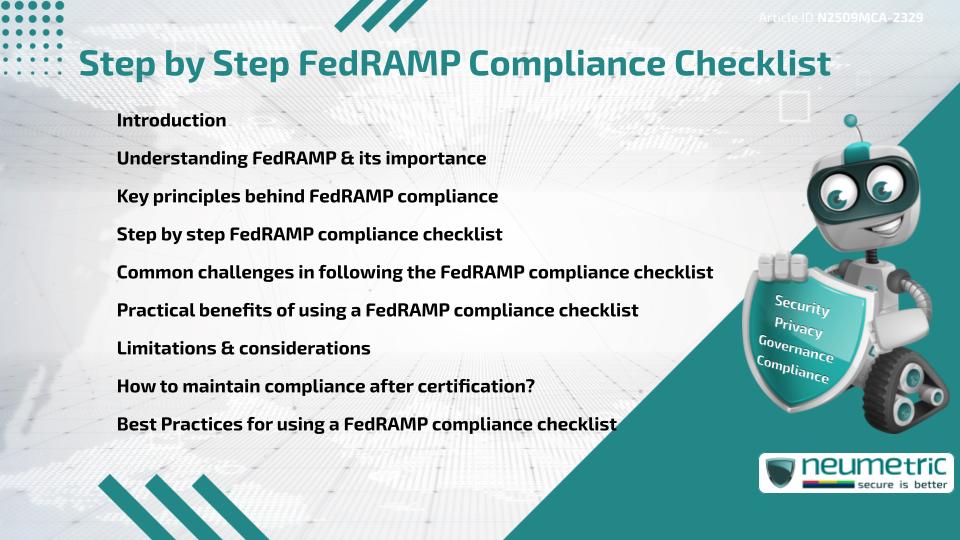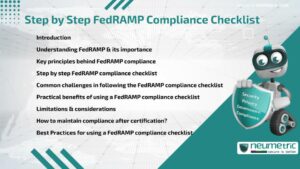Table of Contents
ToggleIntroduction
The FedRAMP Compliance Checklist is a structured roadmap that guides Organisations in meeting the Federal Risk & Authorization Management Program [FedRAMP] requirements. It ensures cloud service providers comply with strict federal security standards before offering solutions to U.S. Government agencies. This article explains the step by step FedRAMP Compliance Checklist, its importance, key principles, challenges, practical benefits & Best Practices. By following this guide, Organisations can understand how to achieve & maintain compliance with confidence.
Understanding FedRAMP & its importance
FedRAMP was established to provide a standardised approach to security Assessment, authorization & monitoring for cloud products. It helps federal agencies adopt secure cloud technologies while reducing Risks. Without FedRAMP, agencies would need to conduct separate Security Assessments for each cloud service, wasting time & resources. The FedRAMP Compliance Checklist streamlines this process by offering a unified path to authorization.
For deeper insights, the official FedRAMP website outlines its goals & Framework. Independent resources such as CISA’s Cloud Security guidance also highlight why uniform security standards are vital for protecting Government data.
Key principles behind FedRAMP compliance
The FedRAMP Compliance Checklist is built on four Core Principles:
- Standardization: Uniform processes for assessing Cloud Security.
- Transparency: Clear documentation & reporting for agencies.
- Risk-based approach: Focus on managing the highest Risks first.
- Continuous Monitoring: Ongoing evaluation rather than one-time approval.
These principles ensure federal data hosted in the cloud remains secure, consistent & auditable.
Step by step FedRAMP compliance checklist
The FedRAMP Compliance Checklist involves the following key steps:
- Understand the impact level: Determine if your system is low, moderate or high impact according to FIPS 199.
- Select a path to authorization: Choose between agency sponsorship or the Joint Authorization Board [JAB].
- Prepare security documentation: Develop a System Security Plan [SSP] that maps your controls to NIST 800-53.
- Engage a Third Party Assessment Organisation [3PAO]: Independent assessors validate your system’s compliance.
- Submit for review: Agencies or JAB evaluate your package & provide feedback.
- Authorization decision: If successful, you receive an Authority to Operate [ATO].
- Continuous Monitoring: Submit monthly reports & perform annual reassessments to maintain compliance.
This step by step FedRAMP Compliance Checklist ensures no requirement is overlooked.
Common challenges in following the FedRAMP compliance checklist
While the checklist provides structure, Organisations often face hurdles such as:
- High costs of Assessment & documentation.
- Limited internal expertise in federal security frameworks.
- Long timelines, sometimes taking over a year.
- Difficulty in maintaining Continuous Monitoring requirements.
Resources like GAO reports on federal IT security shed light on these recurring challenges.
Practical benefits of using a FedRAMP compliance checklist
Using the FedRAMP Compliance Checklist provides several advantages:
- Simplifies a complex process into actionable steps.
- Improves chances of achieving ATO successfully.
- Builds trust with federal agencies by showing commitment to security.
- Reduces redundant work by aligning with NIST controls.
In practice, Organisations that use the checklist save time & avoid costly mistakes.
Limitations & considerations
Despite its advantages, the FedRAMP Compliance Checklist has limitations. It can feel rigid, leaving little room for flexibility in unique technical environments. Smaller companies may struggle with resource requirements compared to larger providers. Moreover, meeting the checklist does not guarantee authorization if security Risks remain unresolved.
How to maintain compliance after certification?
Achieving ATO is not the end. Continuous Monitoring is essential. Providers must regularly update their SSP, conduct Vulnerability scans & submit reports. Agencies expect consistent transparency, making long-term compliance as important as initial certification.
Best Practices for using a FedRAMP compliance checklist
Organisations can maximize success with these practices:
- Begin with a Gap Analysis before formal Assessment.
- Assign a dedicated compliance team or leader.
- Leverage automation tools for monitoring & reporting.
- Maintain strong communication with agencies throughout the process.
By adopting these Best Practices, the FedRAMP Compliance Checklist becomes more than a requirement-it becomes a tool for long-term operational security.
Takeaways
The FedRAMP Compliance Checklist is essential for cloud service providers seeking to work with federal agencies. It simplifies complex Compliance Requirements into manageable steps, highlights Risks & supports long-term security. While challenges exist, Organisations that follow the checklist & embrace Best Practices can achieve & maintain compliance more effectively.
FAQ
What is the FedRAMP Compliance Checklist?
It is a structured list of steps that guide Organisations through FedRAMP authorization & ongoing Compliance Requirements.
Who needs to follow the FedRAMP Compliance Checklist?
Cloud service providers offering solutions to U.S. Government agencies must follow it.
How long does the FedRAMP compliance process take?
It can take several months to more than a year depending on the system’s complexity & chosen authorization path.
What are the three impact levels in FedRAMP?
Low, moderate & high impact levels define the sensitivity of data handled by the system.
Do all cloud providers need FedRAMP authorization?
Only those working with federal agencies require it. Commercial cloud providers outside federal contracts do not.
Can small companies achieve FedRAMP compliance?
Yes, though resource & cost challenges may make it more demanding compared to larger providers.
What happens after achieving FedRAMP authorization?
Providers must perform Continuous Monitoring, submit monthly reports & undergo annual assessments.
Need help for Security, Privacy, Governance & VAPT?
Neumetric provides organisations the necessary help to achieve their Cybersecurity, Compliance, Governance, Privacy, Certifications & Pentesting needs.
Organisations & Businesses, specifically those which provide SaaS & AI Solutions in the Fintech, BFSI & other regulated sectors, usually need a Cybersecurity Partner for meeting & maintaining the ongoing Security & Privacy needs & requirements of their Enterprise Clients & Privacy conscious Customers.
SOC 2, ISO 27001, ISO 42001, NIST, HIPAA, HECVAT, EU GDPR are some of the Frameworks that are served by Fusion – a SaaS, multimodular, multitenant, centralised, automated, Cybersecurity & Compliance Management system.
Neumetric also provides Expert Services for technical security which covers VAPT for Web Applications, APIs, iOS & Android Mobile Apps, Security Testing for AWS & other Cloud Environments & Cloud Infrastructure & other similar scopes.
Reach out to us by Email or filling out the Contact Form…





